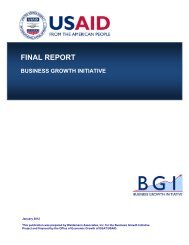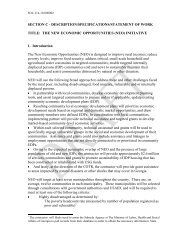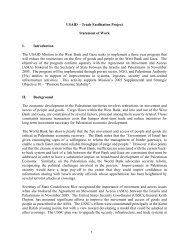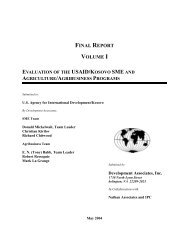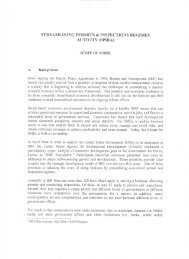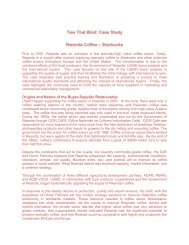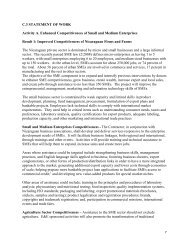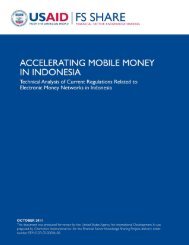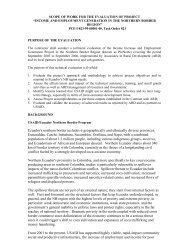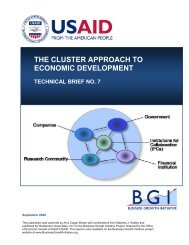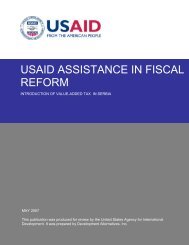Property Tax Reform in Developing and Transition Countries
Property Tax Reform in Developing and Transition Countries
Property Tax Reform in Developing and Transition Countries
You also want an ePaper? Increase the reach of your titles
YUMPU automatically turns print PDFs into web optimized ePapers that Google loves.
example, it was reported that one of every four properties <strong>in</strong> Peru is not reported <strong>in</strong> the real estate cadastre<br />
<strong>and</strong> less than 40 percent of the excluded properties are <strong>in</strong> slums. In Chile, half of recent new construction<br />
is not <strong>in</strong>cluded. In Kenyan municipalities, the coverage ranges from 30-70 percent (Kelly, 2000). And <strong>in</strong><br />
Gabon, another <strong>in</strong>terest<strong>in</strong>g example, there are 45,000 properties identified, but only 15,000 titles<br />
(Monkam, 2008).<br />
How does a government go about putt<strong>in</strong>g its cadastre <strong>in</strong> place This is a tall order for most develop<strong>in</strong>g<br />
countries. The completion of a full cadastre can be an expensive project, though these costs have become<br />
more manageable because of the use of GIS systems <strong>and</strong> tax mapp<strong>in</strong>g. 13 The titl<strong>in</strong>g exercise is no less<br />
daunt<strong>in</strong>g <strong>in</strong> most low-<strong>in</strong>come countries. Both exercises require a comb<strong>in</strong>ation of local knowledge <strong>and</strong><br />
outside technical assistance. The question is whether government will, or should, spend that much money<br />
for so little revenue return.<br />
A further question revolves around whether the development <strong>and</strong> ma<strong>in</strong>tenance of a cadastre can be done<br />
better <strong>in</strong> develop<strong>in</strong>g <strong>and</strong> transition countries by a central authority or by a local government. In fact, both<br />
approaches <strong>and</strong> many variations of each are used. In some transition countries <strong>in</strong> Eastern Europe, the<br />
organizational responsibility for the records <strong>and</strong> for valuation lies with a central authority, such as the<br />
State L<strong>and</strong> Cadastre <strong>in</strong> Lithuania (Aleksiene <strong>and</strong> Bagdonavicius, 2008). A central valuation authority<br />
arguably is able to gather more professional expertise <strong>in</strong> a s<strong>in</strong>gle place, <strong>and</strong> develop better analytic<br />
systems. Lithuania’s fully computerized property registration system l<strong>in</strong>ks data bases on l<strong>and</strong> <strong>and</strong><br />
build<strong>in</strong>gs <strong>and</strong> <strong>in</strong>cludes all parcels <strong>in</strong> the country.<br />
Some would be more cautious about rely<strong>in</strong>g on a central authority. Kelly (2000) argues that when local<br />
governments receive the revenues, efficiency dem<strong>and</strong>s that they must play the major role <strong>in</strong> preparation of<br />
the tax roll <strong>and</strong> <strong>in</strong> assessment. In several Lat<strong>in</strong> American countries (e.g., Guatemala <strong>and</strong> Mexico), there<br />
has been a gradual shift of adm<strong>in</strong>istrative responsibilities to local governments, follow<strong>in</strong>g their capacity to<br />
absorb these new responsibilities (De Cesare, 2004). In Brazil, responsibility for property tax<br />
adm<strong>in</strong>istration rests fully with the local governments. In Uruguay, the central government is responsible<br />
for the cadastre <strong>and</strong> valuation, except <strong>in</strong> Montevideo, which has developed its own cadastre <strong>and</strong> valuation.<br />
There are no straightforward rules that tell us whether central or local adm<strong>in</strong>istration is “better”.<br />
Moreover, a division of property tax adm<strong>in</strong>istration tasks is feasible. If the central government is<br />
responsible for register<strong>in</strong>g property ownership, then it is probably reasonable for it to ma<strong>in</strong>ta<strong>in</strong> the<br />
cadastre. Central governments have other reasons (than property tax) for need<strong>in</strong>g access to records of<br />
l<strong>and</strong> ownership. Moreover, valuation manuals, tra<strong>in</strong><strong>in</strong>g, <strong>and</strong> technical assistance <strong>in</strong> matters such as<br />
computerization can be a central government responsibility. But where the property tax is a local revenue<br />
source, the higher level government may not have enough of a vested <strong>in</strong>terest to value <strong>and</strong> do aggressive<br />
collection, <strong>and</strong> the case becomes very strong for local government responsibility. Oversight, as <strong>in</strong> the<br />
calculation of sales-assessment ratios <strong>and</strong> collections rates, are best carried out by a senior level<br />
government.<br />
6.2.2 Record Keep<strong>in</strong>g<br />
It is important to ma<strong>in</strong>ta<strong>in</strong> <strong>and</strong> constantly upgrade record keep<strong>in</strong>g methods <strong>and</strong> systems. The master file<br />
should <strong>in</strong>clude full <strong>in</strong>formation for each parcel, <strong>in</strong>clud<strong>in</strong>g a physical description of the property,<br />
assessment <strong>and</strong> tax payment history, <strong>and</strong> tenure <strong>and</strong> ownership <strong>in</strong>formation. In many countries, only<br />
13 We use the term “cadastre” <strong>in</strong> the general sense to refer to all l<strong>and</strong> records, ownership records, <strong>and</strong> property tax<br />
<strong>in</strong>formation (also see Almy, 2004).<br />
17



